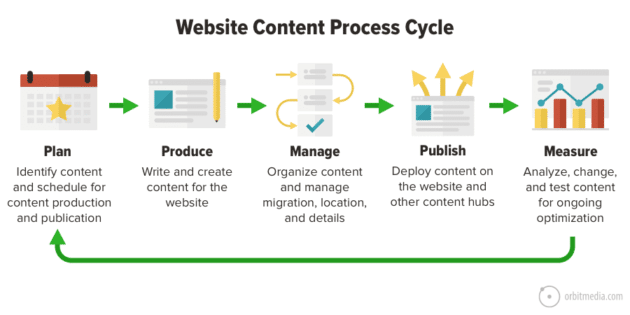Article Note: This article “How to Manage Your Marketing Operations as a Small Business Owner?” was first published on February 18, 2022. We last updated this article with fresh information on January 21, 2023.
Whether you own a restaurant, a photography studio, or an online fashion store, you are going to need to promote your business to your potential customers. But with tight schedules and logistics, managing marketing on your own can be difficult. That is why most small business owners decide to outsource their marketing operations to an agency. This helps them to focus on what they do best.
But what if you don’t quite have the budget or intent to outsource your marketing to an agency? You can surely manage it on your own with a few tactics up your sleeve. In this article, we are going to share with you everything that you need to know to build and manage your marketing processes without spending a fortune. So, let’s jump right into it.
1. Optimizing your website for SEO

Having a website is not enough. You will also need to involve in various marketing activities to make sure your website is visible to the right people at the right time. If you don’t have a website yet, you can build it on your own using stock templates and high-resolution images of your business.
The easiest way to build a website is through WordPress website builder. It allows you to create a website from scratch. WordPress also offers various plugins. You can add functionalities that will make your website easy to navigate for users and search engines alike. For example, you can install a plugin like WooCommerce to add eCommerce functionality to your site. Or, you can use an appointment booking plugin like Amelia to handle appointments better.
Once you have your website live, the next step is to optimize it for visibility across search engines. You might think that search engine optimization is time-consuming and tricky and should be left to professionals. But that’s not entirely true. You know your business and target customers better than anyone else does. So, as a business owner, you can do your basic SEO better than any agency.
The first step is to optimize your meta titles and meta descriptions using popular keywords in your niche. If you are a local business, you can suffix the keyword with your location to bypass the competition and allow your customers to find you easily. For instance, if you offer wedding photography services in Rochester, New York, you can use target keywords like ‘wedding photography in Rochester’, ‘wedding photographer in Rochester’, ‘documentary photography in Rochester’, or any keyword that your customers may use to find you online.
If you can’t think of any relevant keywords, there are plenty of free keyword research tools to help you.
Recommended for you: How to Start a Small Business with PPC Ads?
2. Creating effective content for your website

Your website is the salesman that works 24/7 to generate leads for you. And you must make sure that your website not only strikes the conversation but also answers every question before it is even asked. If your website is not able to qualify visitors as customers, there’s no point in having the website in the first place.
So, how to create website content that converts? Let’s assume you want to create content for your wedding photography website.
Putting yourself in your customer’s shoes is a great place to start. Imagine you are getting married in two weeks, and you want to finalize your photographer in the next couple of days. You want someone who operates locally so that you don’t have to pay for their transportation and accommodation. And since you want everything to be perfect, you want someone who is experienced and can provide a few examples of their work upon request. And then comes the pricing. It doesn’t have to be the cheapest but fair and just.
With these pointers in mind, you can then create website content that addresses these concerns clearly so that when the customer calls you, it is for booking an appointment and not for asking questions.
The infographic below may help you streamline your website content creation.
Image Source: orbitmedia.com.
3. Building backlinks
Backlinks are the backbone of your website. It is one of the most important off-page activities that help your website gain footing in the industry and visibility across search engines.
One of the most effective ways to earn backlinks for your website is to reach out to bloggers in your niche via email or social media and ask them to link to you. While this process can be really time-consuming and frustrating, here’s what you can do instead.

There are many bloggers out there who do not require much convincing. They can link out to your website for a nominal one-time fee while adhering to organic practices. Depending on the website’s metrics like DA and traffic, one backlink can cost you from $50 to $1000 and even more. Let’s say you go with $100 per link, it’d still be cheaper than outsourcing your backlink operations to an agency.
To find opportunities for placing your link or even publishing a guest article, try to search for ‘Guest Posts Sites’ in <your niche> on Google, and you’ll be presented with a list of verified sites that you can reach out to for links.
4. Creating a Google My Business profile
A Google My Business or GMB profile puts your business on the map, allowing your customers to easily find you. It’s a free service by Google that helps local businesses increase their online reach and generate leads. By creating a GMB profile, some businesses may generate even more leads than with their website.
For example, if someone needs a locksmith service immediately, they probably don’t want to waste time visiting websites and reading blog content. All they want is a phone number to call a specialist and solve their problem. But if people are looking for a local pizzeria, they are going to need more than just a phone number.

GMB profile allows you to add your phone number, directions to your outlet/office, and even customer reviews. You can also share the latest photos, news updates and discount offers with your customers by creating short GMB posts on a regular basis.
You may like: 10 Excellent Ideas to Automate Tasks in Your Small Business.
5. Building social media presence
Social media platforms have reached a saturation point where they no longer reward businesses with exposure unless they create something extraordinary or run paid campaigns to get noticed. There’s nothing wrong with paid campaigns. But, sometimes you ought to throw ideas at the problem and not your hard-earned money.
A majority of small businesses fail to drive engagement and build an impressive social media presence because they target the wrong people. It may come as a surprise, but your social media campaigns shouldn’t only be geared toward your prospects or customers. Because if you think your potential customers can generate enough activity to make your social media profiles stand out and bring in new clients, you are mistaken.

Then whom should you target?
Consider people who work in the same industry as you. Why not? You can target your peers or beginners in your industry with your social media campaigns.
Again, let’s consider photography services as an example. By sharing tricks of the trade and valuable information on your social media handles, you can encourage aspiring photographers to engage with your content and follow your profile for future posts.
And as you manage to grow a sizable following of budding and intermediate photographers and other professionals in the industry, you will establish yourself as an authority, and sooner or later, your potential clients will notice.
This tactic can be applied to any business that wants to grow its social media presence and boost engagement.
- Do you own a restaurant? Then, share your recipes.
- Are you a photographer? Then, share your photo editing techniques or how to capture stunning photos in dim light, or how to add transitions to your videos.
- Are you a digital marketer? Then, share your case studies as well as techniques that brought you success.
No matter what you do, there’s always something that you can share with your peers and add value to their lives.
6. Using LinkedIn for lead generation

When it comes to social media, Facebook and Instagram are the top picks for small businesses to promote their products and services. However, they often underestimate the power of LinkedIn as a lead-generation channel.
LinkedIn has over 722+ million users. Thanks to its unique positioning, LinkedIn’s user base is mainly comprised of corporates, vendors, influencers, and decision-makers in the B2B sphere. LinkedIn is a goldmine of leads for B2B businesses and independent contractors. It may seem counterintuitive to your B2C positioning. But, you can still build and run a LinkedIn lead generation strategy to increase revenue.
For instance, photographers can target organizations through LinkedIn for corporate headshots, conferences, and events. Furthermore, LinkedIn is not just a medium to find clients. It’s also a great platform to find vendors within your industry and build long-term collaborations for mutual benefits.
You may also like: How to Setup a Small Business Office for Success?
Takeaway

When you are running a business, it can be difficult to spare time and energy for marketing activities. But you should try to devote one or two hours to marketing every day following the above-mentioned tips. I am sure, you can take your business to the next level and increase your revenue.
This article is written by Stefan Smulders. Stefan is a SaaS entrepreneur, bootstrapped to €3M ARR in just one 1year. He is the founder of the world’s safest software for LinkedIn automation Expandi.io, a vegan, and a father.

 This article is written by Stefan Smulders. Stefan is a SaaS entrepreneur, bootstrapped to €3M ARR in just one 1year. He is the founder of the world’s safest software for LinkedIn automation Expandi.io, a vegan, and a father.
This article is written by Stefan Smulders. Stefan is a SaaS entrepreneur, bootstrapped to €3M ARR in just one 1year. He is the founder of the world’s safest software for LinkedIn automation Expandi.io, a vegan, and a father.



